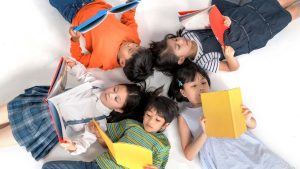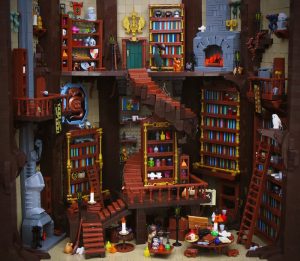I Can Do Anything! : Hyperlinked Communities

I am here because of Lavar Burton. I mean, no, not really. But yes, really, kind of? A lot of us of a certain age are here because of Lavar Burton, and his seminal show, Reading Rainbow. I mean, I was a child of the 80s! Lavar Burton and his friends made reading COOL. There were kids that looked like ME. I did not grow up in a community with many Hapa kids, I was generally the only one. It never felt problematic when I was really young, but no place is perfect and, like so many of us, I definitely was on the receiving end of multiple unkindnesses. Reading Rainbow allowed me to see myself–on TV of all places–and to know that I wouldn’t always be alone in my minority-ness.
And the books! Reading Rainbow had stories about animals. Families. Classrooms. In short, the stuff a kid’s world is made of. Jessica Klinkler (2020), in her essay on the value and strength of childhood reading, declares, “In the safe pages of a book, readers can explore different viewpoints and navigate diverse challenges as they walk in the footsteps of numerous characters. Books can serve as mirrors, allowing readers to see themselves reflected in characters who might be experiencing situations or challenges similar to their own.” But why stop at giving this space only to kids? Giving all of us, children and adults alike, the tools to access people and places that may be unfamiliar, to build empathy, and to see ourselves in situations they we may never encounter, or even to recognize the people we know in a book situated far from home, is the gift of books, and reading. Libraries are uniquely situated to foster these empathy exchanges, as they are often one of the first places people encounter differences: physical, relational, material.
In a white paper about the necessity of diversity of children’s materials and intercultural programming, Jamie Campbell Naidoo (2014) states the position
As our nation continues to diversify, it is essential that children learn to understand the important role of their culture and the cultures of other people in creating an overall global culture respectful of differences. By including diversity in its programs and collections, the library has the potential for helping children make cross-cultural connections and develop the skills necessary to function in a culturally pluralistic society.

Of course, children are not alone in longing to see themselves, and to see themselves in others. As #BookTok neatly demonstrates, the traditional gatekeeping of publishers and critics are no longer sufficient for so many people, and those people have taken to TikTok with joy and love (Jensen, 2022). The hyperlinked library does well to incorporate this into their programming–by paying attention, and meeting new library patrons where they are, offering the books. and services that are most wanted and desired, new patrons can discover the very old brand “Library.” Being responsive to trends and ideas, it isn’t a stretch to say that community-building happens in the fresh air and fresh ideas that blow in.
With this in mind, the Library has an awesome opportunity to build the world that we’d like to see. Michael Stevens (2016) writes that “across our communities and across cultures, understanding, empathy, and kindness matter in everything we do” (p. 81). We, the active members of the Library writ large, can build the world, can build the library, as we see fit. Lavar Burton would definitely approve.

References
Jensen, K. (2022, February 10.) As seen on #BookTok: Inspiring young readers, TikTok is a boon for books. School Library Journal. https://www.slj.com/story/as-seen-on-booktok-inspiring-young-readers-tiktok-is-a-boon-for-books-libraries
Klinkler, J. (2020, July 24). The healing power of books: Using reading to address social and emotional needs. Gale. https://blog.gale.com/the-healing-power-of-books/
Naidoo, J. C. (2014). The importance of diversity in library programs and material collections for children. Association of Library Services for Children. https://www.ala.org/sites/default/files/alsc/content/ALSCwhitepaper_importance%20of%20diversity_with%20graphics_FINAL.pdf
Stephens, M. (2016). The heart of librarianship: Attentive, positive, and purposeful change. ALA Editions.
5 Comments
Maria Haeflinger
Mei,
I had forgotten about Reading Rainbow until this course. He is one that many remember in their early reading years. Everyone had value, and anyone could learn to read. No one was looked down upon or discriminated against. WE WERE ALL EQUAL. We did not see each other as different. When did kids start seeing each other as different? Anyway, Lavar had a real intercommunity of kids on his show.
Knowing what I know now as an adult. I wonder if even then the media was pushing for diversity to not leave anyone out?
As a university librarian, I have not seen my international students in a different light than others, except when I have to work on ways to explain things to them in a way they will understand. My Rwandan students were my greatest challenge. The culture is so different in ways in Rwanda when it comes to education and the expectations to earn a degree.
I wonder how they would see Reading Rainbow? Would they see bias or diversity?
Thank you for helping me go down memory lane with my childhood learning community that was on television every day after school.
@mariahaeflinger
esperanza
Hi Mei,
As a brown-skinned tone Latina, I too also found it really exciting when I read books that represented me. Because Latines in media are typically on the lighter-skin tone end (unless, of course, they are a maid or servant because colorism is strong 🙄), even when Latinas were in media, they typically did not look like me. I completely agree that libraries have the opportunities to help create a better world with compassion and understanding. Like you said, we librarians can build the library and the world as we see fit.
Great post!
Michael Stephens
@meic. This: “…and to see ourselves in situations they we may never encounter, or even to recognize the people we know in a book situated far from home, is the gift of books…” What an absolutely lovely sentiment to describe how literature can invoke empathy. I appreciate your focus on young people as well as adults for this post.
Mei C.
Thanks, @michael! I truly believe in the power of literature and reading–and not only for kids! I used to teach high school and it was amazing to me that my students were able to see the people in their neighborhood in the characters that we would read about. But what is great reading other than learning, recognition, and empathy? Hopefully we’re taught that from a very young age–but I think it would be good too if that lesson continued on well into adulthood. I can certainly think of a few people who could benefit from it!
Michael Stephens
@mei ❤️❤️❤️